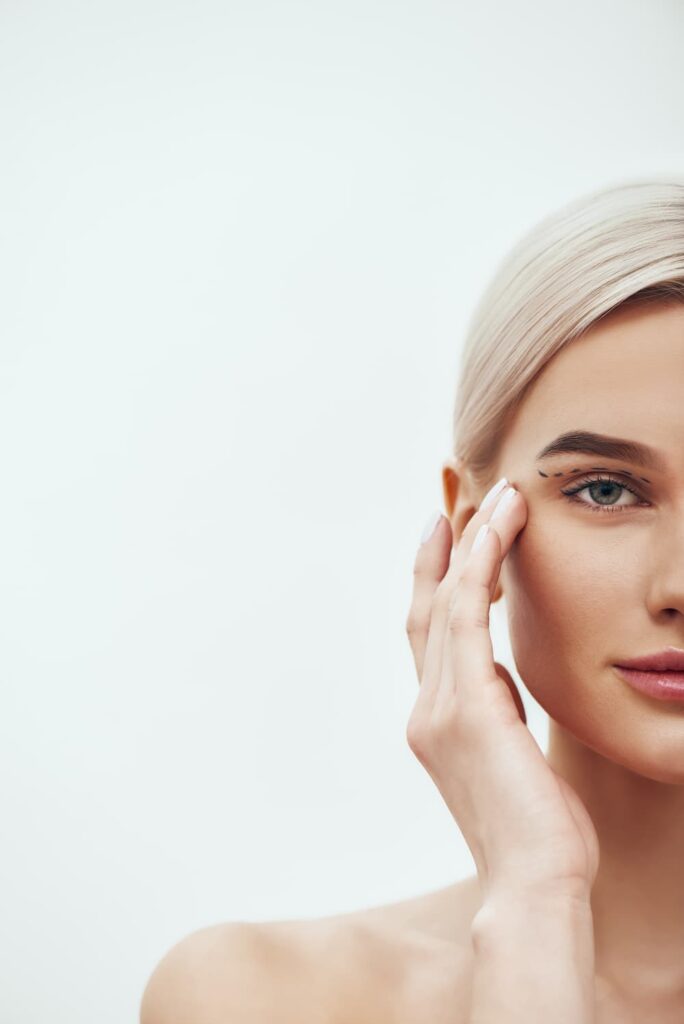Blepharoplasty, also known as eyelid surgery, is a surgical procedure performed to rejuvenate the appearance of the eyelids by addressing concerns such as excess skin, fat deposits, and muscle laxity. It can be performed on both the upper and lower eyelids, and the specific approach depends on your individual needs and desired outcomes.
What is an Upper Eyelid Blepharoplasty Procedure?
The upper eyelid blepharoplasty procedure focuses on correcting cosmetic and functional issues of the upper eyelids. The indications for upper lid blepharoplasty include:
Excess Skin
Over time, the skin of the upper eyelids can become loose and saggy, resulting in a tired or aged appearance. Upper lid blepharoplasty can remove the excess skin, resulting in a more refreshed and youthful look.
Fat Deposits
Some individuals develop prominent or bulging fat pads in the upper eyelids, which can create a puffy appearance. These fat pads can be carefully addressed during the procedure to achieve a smoother contour.

Hooding of the Eyelids
When the excess skin of the upper eyelids droops over the eyelashes, it can impair vision and create a tired or heavy appearance. Upper blepharoplasty can correct this condition by removing the excess skin and improving the eyelid contour. This should be differentiated from true eyelid ptosis where the lid itself is drooping because of an intrinsic issue with the muscles of the eyelid.
During upper lid blepharoplasty, incisions are typically made along the natural crease of the upper eyelid, allowing for a hidden scar. The excess skin and fat is removed. The incisions are then closed with fine sutures.
What is a Lower Lid Blepharoplasty?
The lower lid blepharoplasty procedure addresses concerns related to the lower eyelids and is commonly performed to improve the appearance of under-eye bags, wrinkles, and sagging skin. The indications for a lower lid blepharoplasty include:
Under-Eye Bags
The lower eyelids can develop fat deposits or puffiness, commonly known as under-eye bags. Lower blepharoplasty can remove or reposition the excess fat, resulting in a smoother and more youthful contour. Sometimes the puffiness is related to fluid which cannot be corrected surgically. The lower eyelid bags should be differentiated from malar festoons with which they are often confused
Excess Skin and Wrinkles
With age, the lower eyelid skin can become lax and wrinkled. Lower blepharoplasty can remove the excess skin and tighten the lower eyelid, reducing the appearance of wrinkles and creating a more refreshed look.
Tear Trough Deformity
The tear trough is the groove that extends from the inner corner of the eye to the cheek. In some individuals, this area can become hollow or depressed, creating a tired or aged appearance. Lower lid blepharoplasty can address this concern by filling in or repositioning the fat and tissue, restoring a smoother transition between the lower eyelid and cheek.
During the lower lid blepharoplasty, the surgeon makes incisions either just below the lower lash line (transcutaneous approach) or inside the lower eyelid (transconjunctival approach). The choice of incision depends on the specific needs of the patient. Excess fat, muscle, and skin are then adjusted or removed as required to achieve the desired result.
Recovery Time
It’s important to note that each blepharoplasty procedure is highly individualized, and during your consultation, we will assess your specific concerns, discuss your goals, and recommend the most appropriate technique (including nonsurgical options such as laser, radiofrequency and plasma) for you. Recovery time can vary depending on various factors but our certified plastic surgeon recommends planning for 7-10 days.
Please feel free to ask any further questions you may have. We are here to address your concerns and guide you through the process.
Make an Appointment with our Westchester Blepharoplasty Surgeon
Dr. Rothaus is on staff at The New York Presbyterian Hospital-Weill Cornell and at The Hospital for Special Surgery. His Manhattan office and office-based surgery center are located on the Upper East side of Manhattan. Dr. Rothaus has, however, maintained for his Westchester and Connecticut patients a conveniently located Westchester office for almost two decades. He and his staff are available in their White Plains office to provide consultations and take care of all your pre-operative and post-operative care. If you have any questions or concerns about the blepharoplasty procedure, we are here to address them and guide you through the process. Contact our Westchester office to schedule your consultation.

About Dr. Rothaus
Kenneth O. Rothaus, MD is a board-certified Manhattan and Westchester plastic surgeon offering cosmetic and reconstructive surgery for the face, breast, body, and skin. Educated at Yale College and Harvard Medical School, Dr. Rothaus’ general and plastic surgery training was at the Columbia and Cornell campuses of the New York Presbyterian Hospital. Dr. Rothaus values the wants and needs of his patients and strives to give them the best experience possible.
Learn More